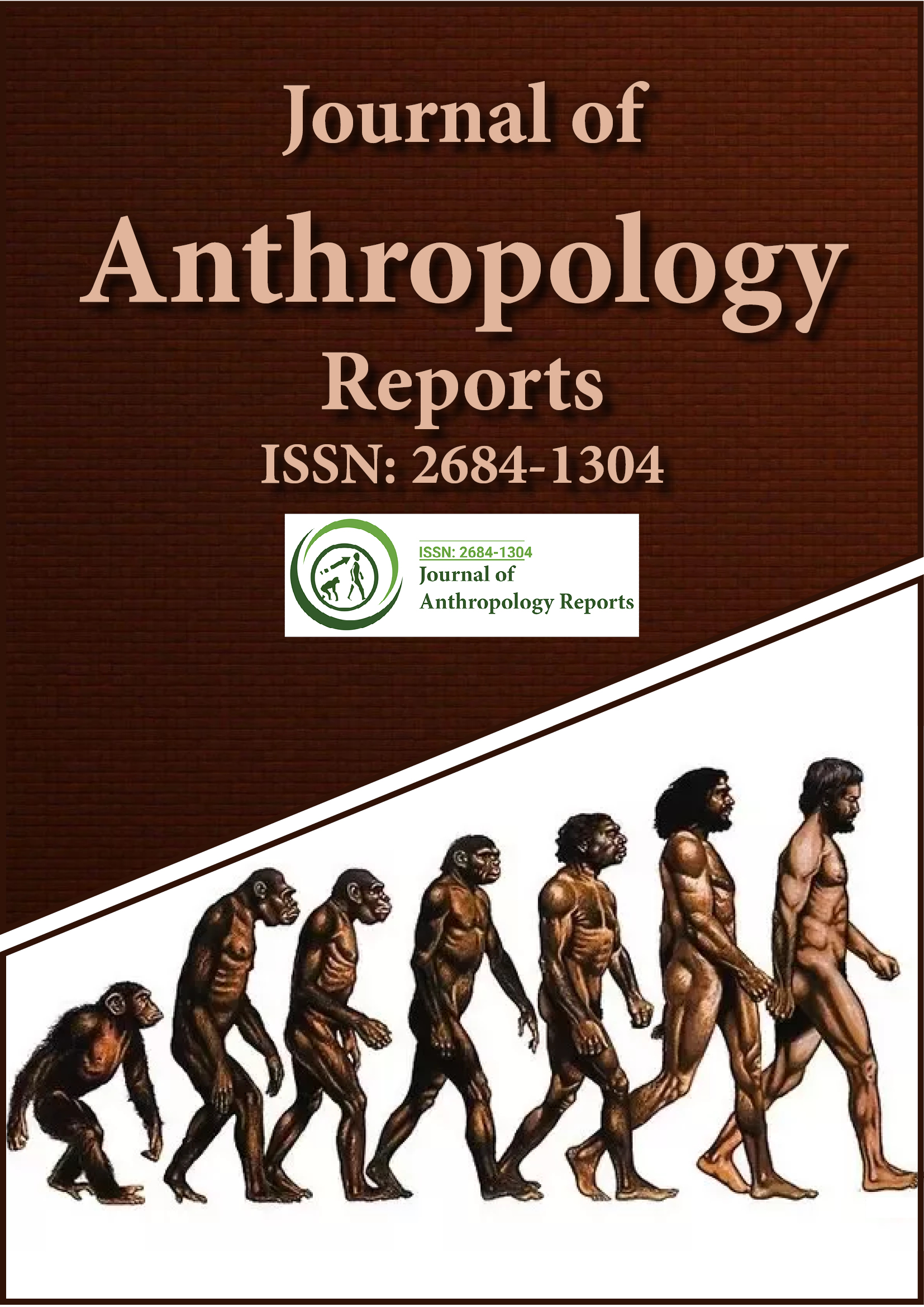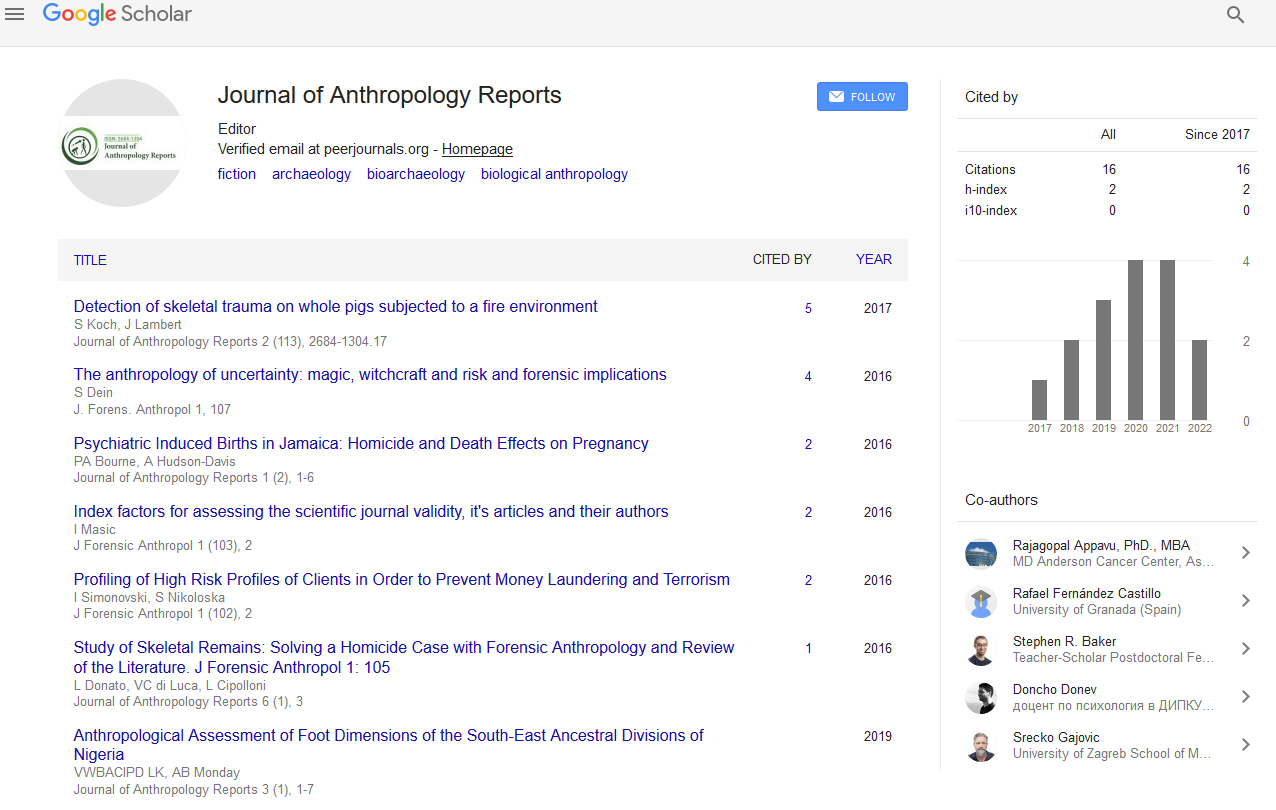Indexed In
- RefSeek
- Hamdard University
- EBSCO A-Z
Useful Links
Share This Page
Journal Flyer

Open Access Journals
- Agri and Aquaculture
- Biochemistry
- Bioinformatics & Systems Biology
- Business & Management
- Chemistry
- Clinical Sciences
- Engineering
- Food & Nutrition
- General Science
- Genetics & Molecular Biology
- Immunology & Microbiology
- Medical Sciences
- Neuroscience & Psychology
- Nursing & Health Care
- Pharmaceutical Sciences
Commentary - (2023) Volume 6, Issue 4
Forensic Anthropology: Recognizing Unexplainable through the Study of Human Remains
Sabah Al-Aisha*Received: 20-Nov-2023, Manuscript No. JFA-23-22435; Editor assigned: 22-Nov-2023, Pre QC No. JFA-23-22435 (PQ); Reviewed: 06-Dec-2023, QC No. JFA-23-22435 (QC); Revised: 13-Dec-2023, Manuscript No. JFA-23-22435 (R); Published: 20-Dec-2023, DOI: 10.35248/2684-1304.23.6.175
Description
Forensic anthropology is a specialized discipline within the field of anthropology that plays a critical role in criminal investigations and medico-legal sciences. This commentary explores the unique subject of forensic anthropology, exploring its historical development, methods, and applications in recognizing mysteries through the study of human remains. From its origins in the late 19th century to its current significance in modern society, forensic anthropology has evolved to become an essential device in the identification of unknown individuals, determination of cause and manner of death, and the pursuit of justice for the deceased. The article also highlights the collaboration between forensic anthropology and other disciplines, such as forensic odontology, and discusses the challenges and future directions in the field. Through a comprehensive examination of unique data and case studies, the article demonstrates the profound impact of forensic anthropology on the resolution of criminal cases and the closure it provides to families of the deceased.
Forensic anthropology is a specialized branch of anthropology that plays a important role in the field of criminal investigations medico-legal sciences. By applying principles from physical anthropology to the analysis of human remains, forensic anthropologists aid in identifying unknown individuals, determining the cause and manner of death, and providing critical information for legal proceedings. This article explores the fascinating world of forensic anthropology, its methods, applications, and the significant impact it has on recognizing mysteries and seeking justice for the deceased.
History and evolution of forensic anthropology
The roots of forensic anthropology can be traced back to the late 19th century when anthropologists began to examine human remains to better understand human variation and evolution. It was not until the early 20 th century that forensic anthropology began to gain recognition as a valuable tool in criminal investigations. The work of pioneers such as T. Dale Stewart and Mildred Trotter laid the groundwork for the application of anthropological techniques to solve legal cases involving unidentified and decomposed bodies.
Role of forensic anthropologists in criminal investigations
Forensic anthropologists work closely with law enforcement agencies and medical examiners to analyse skeletal remains found in various circumstances, including homicides, mass disasters, and cold cases. Their expertise in human osteology, taphonomy (study of post-mortem changes to remains), and forensic archaeology allows them to reconstruct events surrounding the death, estimate time since death, and determine the identity of the deceased. They also provide valuable insight into the individual's age, sex, stature, and possible cause of death.
Methods and techniques in forensic anthropology
Osteological analysis: The examination of skeletal remains is the primary focus of forensic anthropologists. By studying bones, they can identify age, sex, and ancestry, thus narrowing down potential matches with missing persons databases.
Taphonomic analysis: Understanding the post-mortem changes to remains is essential in reconstructing the circumstances of death. Factors such as weather, scavenger activity, and burial environment all leave distinct marks on bones, which forensic anthropologists can interpret.
Facial reconstruction: In cases where the identity of the deceased is unknown, forensic anthropologists may create facial reconstructions using the skull as a base. This technique helps generate leads and aids in the identification process.
Stable isotope analysis: By analyzing the isotopic composition of bone or teeth, forensic anthropologists can infer an individual's geographic origin or migration patterns, providing additional clues about their identity and lifestyle.
Application in mass disasters and human rights investigations
Forensic anthropologists also play a critical role in mass disaster incidents, such as plane crashes, natural disasters, and terrorist attacks. Their skills in body recovery, analysis, and identification help bring closure to families and contribute to the overall investigation. Furthermore, forensic anthropology is instrumental in uncovering evidence of human rights abuses, especially in cases of genocide and mass graves, aiding in the pursuit of justice for victims and their families.
Forensic anthropology and forensic odontology collaboration
Forensic anthropology often collaborates with forensic odontology, the study of dental evidence, to enhance the identification process. Dental records and features can provide vital information, especially when the body is in a highly decomposed state or only skeletonized remains are available.
Legal implications and expert testimony
Forensic anthropologists are frequently called upon to provide expert testimony in court, presenting their findings and interpretations to assist in criminal trials and legal proceedings. The accuracy and reliability of their analyses can significantly impact the outcome of a case, underscoring the importance of rigorous methodologies and ethical practices.
Challenges and future directions
While forensic anthropology has made significant strides in recent decades, there are still challenges to address. These include the lack of standardization in some techniques, limited funding, and the need for ongoing research to improve accuracy and expand the scope of the discipline. The integration of advanced technologies, such as 3D scanning and molecular analysis, promises to revolutionize the field further.
Conclusion
In conclusion, forensic anthropology is a dynamic and ever-evolving field that continues to contribute immensely to the resolution of criminal investigations and the pursuit of justice. Through meticulous analysis of skeletal remains and collaboration with other forensic disciplines, forensic anthropologists help piece together stories that would otherwise remain untold. Their dedication to unearthing the truth and providing closure to families exemplifies the importance of forensic anthropology in modern society.
Citation: Al-Aisha S (2023) Forensic Anthropology: Recognizing Unexplainable through the Study of Human Remains. J Anthropol Rep. 6:175.
Copyright: © 2023 Al-Aisha S. This is an open-access article distributed under the terms of the Creative Commons Attribution License, which permits unrestricted use, distribution, and reproduction in any medium, provided the original author and source are credited.

